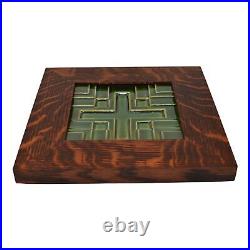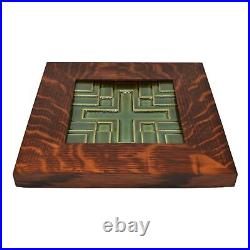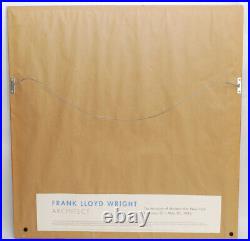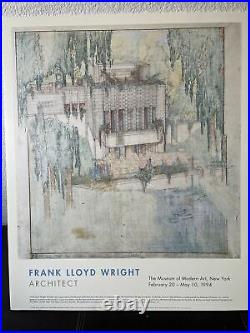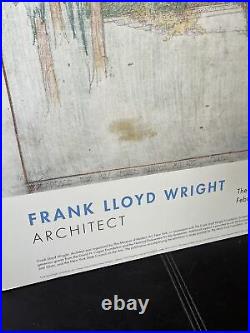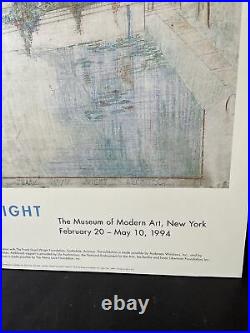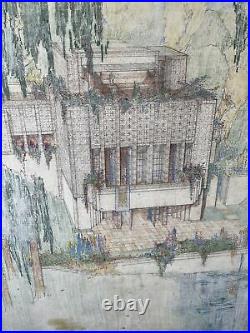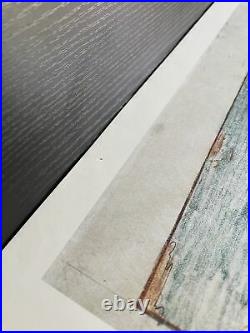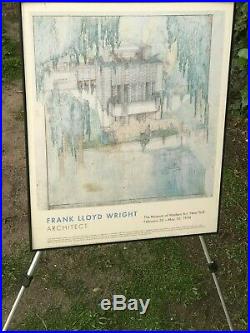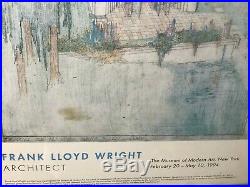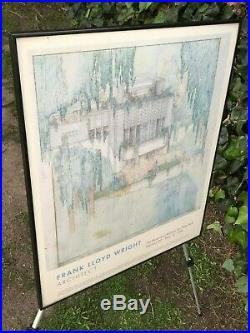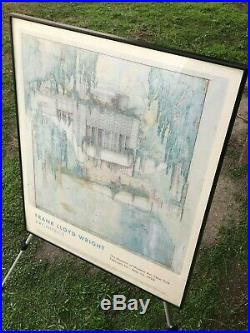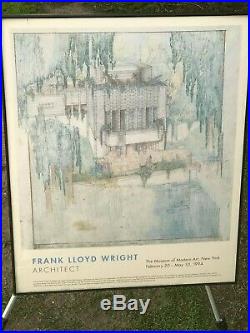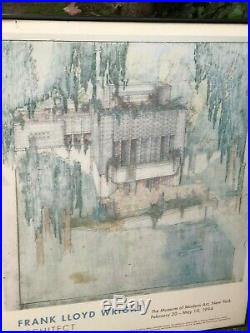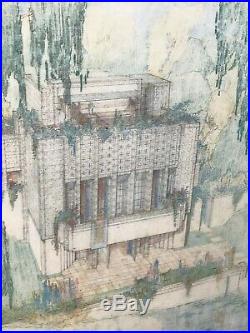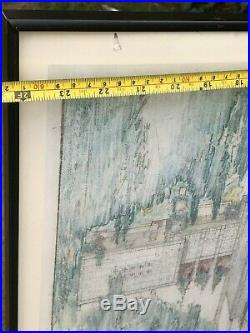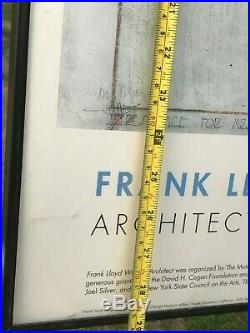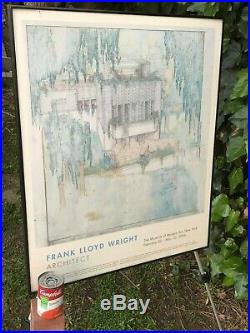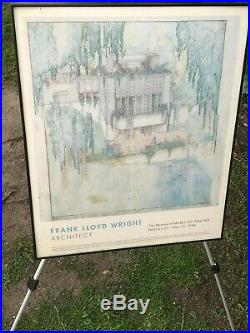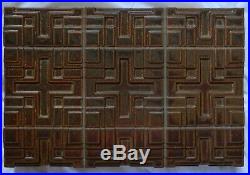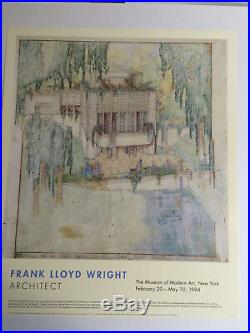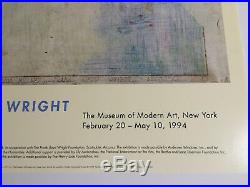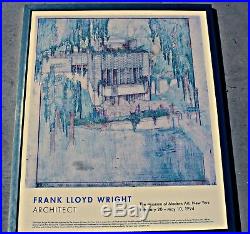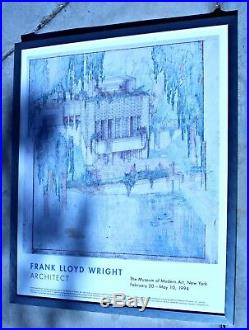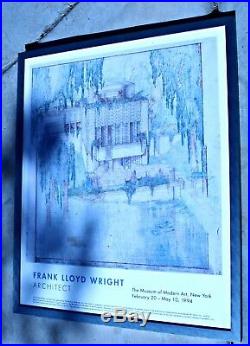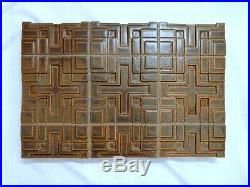Posts tagged millard
Motawi Art Pottery Frank Lloyd Wright Millard House Green Cross Ceramic Tile. Crisp mold with great emerald color and glaze. No chips, cracks, damage or repair of any kind. Frame is 9 1/2″ tall and 9 1/2″ wide. Tile is 6 square. Rare and estate fresh. Complete satisfaction is always guaranteed. We deal only in art pottery and specialize in large estate collections.
This exquisite handcrafted vase is a one-of-a-kind piece from the Frank Lloyd Wright Millard Mid Century Inspired. With a height of 9 inches and a width of 9.75 inches, it is the perfect addition to any home looking to add a touch of nature, garden, or even abstract design to their decor. Its unique design features a smootj finish, intricate carvings, and a 3D effect that provides a textured and decorative look. Made from cement, this vase is finished to be both waterproof and fire-resistant, making it a durable and functional piece. The vase is limited edition and special addition to any collection. Studio crafted South Carolina, USA.
Frank Lloyd Wright 1994 Museum of Modern Art Poster Millard House Pasadena. Back part of poster board had dimples from prior frame. A few small nicks and bends on edge border. This item is in the category “Art\Art Posters”. The seller is “88suns” and is located in this country: US. This item can be shipped to United States.
- Size: Medium (up to 36in.)
- Region of Origin: New York, USA
- Artist: Frank Lloyd Wright
- Character: Frank
- Framing: Unframed
- Country/Region of Manufacture: United States
- Style: Modern
- Material: Poster Board
- Theme: Art
- Type: Poster Board
- Subject: Architecture
- Signed: No
- Year of Production: 1994
- Date of Creation: 1994
- Width (Inches): 24
- Height (Inches): 29
” Millard House, Pasadena ” 1994. Museum of Modern Art New York. (Not the Modern Reprint). New York Museum of Art. Framed in Metal and Glass – 29 in. Excellent Vintage Condition (see photos). In Pasadena, is the earliest in a series known as the Textile Block houses, designed by Wright in the 1920s; all are located in southern California. This color rendering depicts the Millard House in its lush surroundings. The house is constructed of a combination of plain-faced and ornamental concrete blocks, which were cast on the site from molds designed by Wright. The square blocks, with perforated, glass-filled apertures, form a continuous interior and exterior fabric. The relatively small scale of the blocks allows for a design that closely follows the contours of the landscape. In his autobiography, Wright wrote: The concrete block? The cheapest (and ugliest) thing in the building world. Why not see what could be done with that gutter-rat? In his Textile Block houses, Wright attempted to introduce a flexible building system, marrying the merits of standardized machine production to the innovative, creative vision of the artist. While the block system was intended to be an efficient, low-cost method of building that incorporated ornament, it proved to be time consuming and more expensive than traditional construction. Frank Lloyd Wright was born on June 8, 1869, in Richland Center, Wisconsin, the first of three children to William, a preacher, and Anna Wright. When he was twelve years old his family settled in Madison, Wisconsin, and Wright worked on his uncle’s farm at Spring Green during the summers. After the couple divorced in 1885, Frank lived with his mother, and the two shared a lasting relationship. It was from her that he developed an early love for pure geometric forms and designs, which later influenced his architecture. Wright developed a passion for the farmland that never left him. He attended Madison High School and left in 1885, apparently without graduating. He went to work as a draftsman, and the following year, while still working, took a few courses in civil engineering at the University of Wisconsin. In 1887 Wright moved to Chicago, Illinois, worked briefly for an architect, and then joined the firm of Dankmar Adler (18441900) and Louis Sullivan (18561924). Wright was very much influenced by Sullivan, and, although their relationship ended when Sullivan found out that Wright was designing houses on his own, he always acknowledged Sullivan’s influence and referred to him as lieber meister. In 1893 Wright opened his own office. The houses Wright built in Buffalo, New York, and in Chicago and its suburbs before World War I (191418), when German-led forces pushed for European domination, gained international fame wherever there were avant-garde movements in the arts. Similarly, in the United States, Wright’s clients were exceptional individuals and small, adventurous institutions, not governments or national corporations. A small progressive private school (Hillside Home School, Spring Green, 1902) and an occasional private, commercial firm (Larkin Company in Buffalo) came to him, but chiefly, his clients were Midwestern businessmen, practical, unscholarly, independent, and moderately successful, such as the Chicago building contractor Frederick C. Robie, for whom Wright designed houses. Early, Wright insisted upon declaring the presence of pure cubic mass, the color and texture of raw stone and brick and copper, and the sharp-etched punctures made by unornamented windows and doors in sheer walls (Charnley House, Chicago, 1891). He made of the house a compact block, which might be enclosed handsomely by a hipped roof (Winslow House, River Forest, Illinois, 1893). Soon, the delight in the simplicity of a single mass gave way to his passion for passages of continuous, flowing spaces and he burst the enclosed, separated spaces of classical architecture, removed the containment, the sense of walls and ceilings, and created single, continuously modified spaces, which he shaped by screens, piers, and different planes and masses. There was, first, the romantic idea of honest expression: that a building should be faithful in revealing its materials and structure, as Eugène Emmanuel Viollet-le-Duc (18141879) had argued, without any classical ornament or fake surface or structure. There was, second, the idea that a building’s form should reflect its plan, its functional arrangement of interior spaces, as Henry Latrobe and Horatio Greenough had proposed. There was, third, the belief that each building should express something new and distinctive in the times G. Hegel [17701831], Gottfried Semper [18031879] and specifically the new technical resources, such as steel skeletons and electric light and elevators, which suggested skyscrapers and new forms of building (John Wellborn Root). There was, fourth, the ambition, even pride, to achieve an art appropriate to a new nation, an American art, without Continental or English or colonial dependencies. Finally, there was the theory derived by Sullivan from Charles Darwin (18091882) and Herbert Spencer (18201903) that a building should be similar to a biological organism, a unified work of art, rooted to its soil, organized to serve specified functions, and, as a form, evolved as an organism evolves, fitted to its environment, expressive of its purpose. If the handsome Taliesin East, whose roofs are rhythmical accents on the edge of a bluff overlooking two valleys, were all that Wright left, he would be remembered as the finest architect who worked in the nineteenth-century tradition of romantic domestic design. But, early, he prepared an idea and an imagery for modern design. He achieved in the Larkin Building, Buffalo (1904; destroyed) an integration of circulation, structure, ventilation, plumbing, furniture, office equipment, and lighting. Always distinctive and independent, Wright’s style changed often. For about ten years after 1915 he drew upon Mayan (an ancient Indian tribe in Mexico) ornament (Barndall House, Hollywood, California, 1920). Even then Wright avoided the barrenness and abstraction of his designs, he insisted upon having the multiple form of buildings reflect the movement of unique sites: the Kaufmann House, “Falling Water, ” at Bear Run, Pennsylvania (193637), where interlocked, reinforced-concrete terraces are poised over the waterfall; the low-cost houses (Herbert Jacobs House, Madison, 1937); and the “prairie houses” (Lloyd Lewis House, Libertyville, Illinois, 1940). No architect was more skillful in fitting form to its terrain: the Pauson House in Phoenix, Arizona (1940) rose from the desert, like a Mayan pyramid, its battered wooden walls reflecting the mountains and desert. Those brilliant rural houses did not reveal how Wright would respond to an urban setting or to the program of a corporate client. But in the Administration Building for the Johnson Wax Company, Racine, Wisconsin (193639, with a research tower added in 1950), he astonished architects with his second great commercial building (after the Larkin Building). A continuous, windowless red-brick wall encloses a high, window-lighted interior space; that space, which contains tall columns, is one of the most peaceful and graceful interior spaces in the world. At Florida Southern College he set side-by-side circle and fragmented rhombus (a four-sided plane), recalling Hadrian’s Villa at Tivoli, Italy; he set a helix (spiral form structure) inside the Morris Gift Shop in San Francisco, California (194849). Ultimately, he conceived of having the helix surround a tall central space: the six-story Guggenheim Museum in New York City (194659), which paid in significant functional defects to gain a memorable experience in viewing art, especially where the helix affords views into a side gallery below. The architectural drawings Wright left behind are magical and lyrical. No one might ever build accordingly, but Wright was never content with the commonplace or ordinary to the conventional or the practical. He imagined the wonderful where others were content with the probable. Wright’s drawings suggest how far his talent surpassed any client’s capacity fully to realize his dream: a world of sanctuaries and gardens, of earth and machines, of rivers, seas, mountains, and prairies, where grand architecture enables men to dwell nobly. The item “FRANK LLOYD WRIGHT 1994 ORIGINAL EXHIBITION POSTER Millard House Vintage Framed” is in sale since Tuesday, February 12, 2019. This item is in the category “Art\Paintings”. The seller is “777restorations” and is located in Los Angeles, California. This item can be shipped to United States.
- Medium: Watercolor
- Listed By: Dealer or Reseller
- Style: Impressionist
- Subject: Architecture
- Date of Creation: 1990-1999
- Size: Large (up to 60in.)
- Region of Origin: US
- Artist: FRANK LLOYD WRIGHT
- Painting Surface: Paper
- Framed/Unframed: Framed
- Width (Inches): 25
- Height (Inches): 29
- Title: The Millard House
- Features: Framed
- Originality: Limited Edition Print
- Color: Multi-Color
- Quantity Type: Original Vintage
- Year: 1994
MILLARD HOUSE ART TILE EXHIBIT. The wall end of the cleat is missing, but can be easily made on a table saw. This piece weighs almost 14 lbs. I have a similar piece framed in barnwood that hangs in my foyer. This unique presentation by Motawi Tileworks can be framed, incorporated into a backsplash or fireplace or displayed as is. The item “Frank Lloyd Wright Millard House ArtTile Exhibit 12x 18 Motawi Prairie School” is in sale since Friday, November 15, 2019. This item is in the category “Pottery & Glass\Pottery & China\Art Pottery\Other American Pottery”. The seller is “dustymarvel” and is located in Chelsea, Michigan. This item can be shipped to United States, Canada, United Kingdom, China, Mexico, Germany, Japan, Brazil, France, Australia, Russian federation, Denmark, Romania, Slovakia, Bulgaria, Czech republic, Finland, Hungary, Latvia, Lithuania, Malta, Estonia, Greece, Portugal, Cyprus, Slovenia, Sweden, South Korea, Indonesia, Taiwan, South africa, Thailand, Belgium, Hong Kong, Ireland, Netherlands, Poland, Spain, Italy, Austria, Bahamas, Israel, New Zealand, Philippines, Singapore, Switzerland, Norway, Saudi arabia, Ukraine, United arab emirates, Qatar, Kuwait, Bahrain, Croatia, Malaysia, Chile, Colombia, Costa rica, Dominican republic, Panama, Trinidad and tobago, Guatemala, El salvador, Honduras, Jamaica, Antigua and barbuda, Aruba, Belize, Dominica, Grenada, Saint kitts and nevis, Saint lucia, Montserrat, Turks and caicos islands, Barbados, Bangladesh, Bermuda, Brunei darussalam, Bolivia, Ecuador, Egypt, French guiana, Guernsey, Gibraltar, Guadeloupe, Iceland, Jersey, Jordan, Cambodia, Cayman islands, Liechtenstein, Sri lanka, Luxembourg, Monaco, Macao, Martinique, Maldives, Nicaragua, Oman, Peru, Pakistan, Paraguay, Reunion, Viet nam, Uruguay.
- Color: Brown
1994 Museum of Modern Art Poster. Title – La Miniatura, George Madison Millard House. Artist – Frank Lloyd Wright. Paper Size – 24″ x 29″. Image Size – 22″ x 22 3/4″. All of our Prints are from the Authorized Publishers. The item “La Miniatura, George Madison Millard House Frank Lloyd Wright 1994 Print Poster” is in sale since Thursday, October 11, 2018. This item is in the category “Art\Art Prints”. The seller is “printsdirect” and is located in Manahawkin, New Jersey. This item can be shipped worldwide.
- Print Type: Offset Lithograph
- Size Type/Largest Dimension: Medium (Up to 30″)
- Item #: BMG- out of print last one
- Artist: Frank Llyod Wright
- Style: Realism
- Listed By: Dealer or Reseller
- Bin: L20
- Date of Creation: 1994
- Subject: Architecture
Artist: Frank Lloyd Wright. Title: Residence of Mrs. George Madison Millard, Pasadena CA. Condition: Both frame and poster in excellent condition. Size: 29.5 x 30.5. Frame: Silver-tone metal frame, under acrylic. George Madison Millard House, Pasadena, California, 1923. Please look over the photos clearly. There is writing in the lower left corner which indicates “Millard” and then something which may be a designer’s signature. Please look over the photos carefully. They are photos of the exact piece you will receive. Fed Ex needs a street address, rather than a P. Due to size and weight, no international orders please. The item “RARE Orig. 1994 Museum of Modern Art Frank Lloyd Wright Millard House Pasadena” is in sale since Monday, October 22, 2018. This item is in the category “Art\Art Posters”. The seller is “western_estate_sales” and is located in Las Vegas, Nevada. This item can be shipped to United States.
- Subject: Houses
- Style: Modern
- Originality: Open Edition Print
- Listed By: Dealer or Reseller
- Size: Medium (up to 36in.)
- Height (Inches): 30.5
- Width (Inches): 29.5
- Artist: Frank Lloyd Wright
- Features: Framed
- Color: Pale Blues
- Quantity Type: Multi-Piece Work
- Date of Creation: 1994
- Year: 1994
MILLARD HOUSE ART TILE EXHIBIT. A dark brown, photo#1 has been lightened to show detail more clearly. Each tile is approximately 3/4 thick. Tiles are mounted on 5/8 plywood, and can be wall mounted with a french cleat. The wall end of the cleat is missing, but can be easily made on a table saw. This piece weighs almost 14 lbs. I have a similar piece framed in barnwood that hangs in my foyer. This unique presentation by Motawi Tileworks can be framed, incorporated into a backsplash or fireplace or displayed as is. The item “Frank Lloyd Wright Millard House ArtTile Exhibit 12x 18 Motawi Prairie School” is in sale since Monday, March 18, 2019. This item is in the category “Pottery & Glass\Pottery & China\Art Pottery\Other American Pottery”. The seller is “dustymarvel” and is located in Chelsea, Michigan. This item can be shipped to United States.


